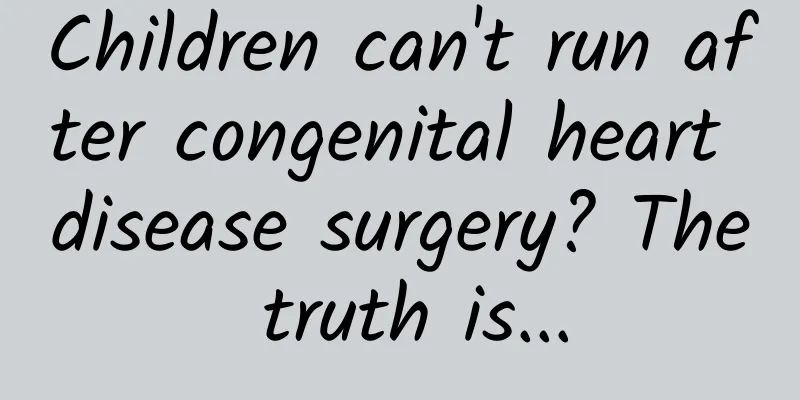Children can't run after congenital heart disease surgery? The truth is...

|
There are many opinions on whether children can exercise after congenital heart disease surgery: "Children cannot exercise after congenital heart disease surgery and must rest." "After the child had congenital heart disease surgery, he can no longer go running for exercise." "After the child had surgery for congenital heart disease, he cannot attend physical education classes and must be exempted from the course." … So, are these statements correct? Congenital heart disease is a common birth defect in my country, and surgery is currently the main treatment method. When these children are recovering from surgery, most parents are most concerned about whether their children should exercise? How should they exercise? Some parents believe that the trauma of heart surgery is so severe that they cannot exercise and need to rest; some parents believe that after exercise, the wound on the child's heart will not heal well and increase the burden on the heart... It can be seen that many parents still have some misunderstandings about whether they can exercise after heart surgery. Today we will analyze the physical activities of children after heart surgery. Copyrighted stock images, no reproduction is authorized Myth 1: Children with congenital heart disease need to rest after major surgery and cannot exercise at all This is a very common misunderstanding. Many people do not have enough knowledge about physical activity and mistakenly believe that long-term rest is required to restore cardiac function after heart surgery. Therefore, they often restrict children's activities, causing them to be sedentary, lack exercise, be overweight, and have decreased cardiopulmonary exercise tolerance. In addition, children with congenital heart disease generally have delayed motor development. In the past, it was believed that this was mainly related to the disease and perioperative complications, but now it is believed that this may also be related to lack of activity. Congenital heart disease surgery is mainly to correct the abnormal heart structure of children. A large number of studies and clinical practices have shown that appropriate physical activity after congenital heart disease surgery is more helpful than bed rest in improving myocardial contractility and improving cardiac function. It can also improve children's skeletal muscle, blood vessels and immune system function, prevent obesity, and improve psychological, cognitive and social functions. Illustration: Yan Sinian, a graduate student at the School of Nursing, Shanghai Jiao Tong University Since we want to get children moving, how long should they exercise every day? The exercise and activity guidelines for congenital heart disease in various countries have given a clear answer to this question. Children with congenital heart disease who have undergone radical surgery or do not need subsequent treatment should avoid being sedentary for more than 2 hours and engage in at least 60 minutes of physical activity every day, at least 3 days a week. Parents can choose appropriate activities based on this activity principle, the age of the child, and different developmental stages. For example, infants and young children aged 0-2 years old should focus on growth and development, and parents can try to do some enjoyable and safe parent-child activities; preschool children should focus on developing motor skills, and parents can let their children participate in daily housework, cycling, ball games, and group activities; children and adolescents should focus on muscle training and resistance exercises, such as dance, aerobics, ball games, etc. Illustration by Yan Sinian, graduate student at the School of Nursing, Shanghai Jiao Tong University Myth 2: Children with congenital heart disease cannot participate in running after surgery This is also a misunderstanding of many people. In fact, the key to whether or not you can run lies in the level of cardiac function after surgery. Running is one of the simplest forms of exercise among all sports. It can effectively improve cardiac function, enhance cardiac contraction and relaxation function and cardiac capillary density, and improve cardiac regulation function. The subtle effects of running may be difficult for people to detect, but as an important indicator of cardiac function, heart rate, can be monitored by us through wearable technology. For example, when we are quiet, our heart rate begins to decrease; when we exercise, our heart rate will increase. A person who runs regularly has a significantly lower heart rate at rest than a person who does not exercise, which prolongs the diastole of the heart and gives the heart more time to return blood and fill it to prepare for the next contraction. Therefore, children who run regularly and scientifically will have better cardiopulmonary function. However, after congenital heart disease surgery, children cannot run at a high intensity, otherwise it will increase health risks. Scientific running is the key. Usually, we use metabolic equivalents (METs) to divide the intensity of children's physical activity into: METs values <3 for low-intensity activities, 3-5.9 for moderate-intensity activities, and ≥6 for high-intensity activities. According to the METs value of energy expenditure of physical activities of children and adolescents, the METs values of different physical activities are different. Taking running as an example, the jogging of children aged 6-9 is 5.5METs (medium intensity), while sprinting can reach 7.2METs (high intensity). It can be seen that the METs values of running at different paces are different, and normal running does not belong to the concept of strenuous exercise. Therefore, parents can set the appropriate running speed for their children according to their cardiopulmonary function level, and exercise from slow to fast, step by step, so as to achieve the purpose of cardiac rehabilitation. Illustration by Yan Sinian, graduate student of the School of Nursing, Shanghai Jiao Tong University Myth 3: Children with congenital heart disease cannot attend physical education classes after surgery and should be exempted from physical education classes This view is incorrect. Because children with congenital heart disease have congenital malformations and delayed growth and development, their cardiopulmonary function is indeed different from that of children of the same age, and their aerobic metabolic capacity is relatively low. Therefore, many parents will overprotect their children and limit the amount of outdoor activities for children after surgery, and exemption from physical education classes has become a normal practice. In fact, restricting physical education classes will not only affect children's physical development and cardiopulmonary function, but also isolate them from society and cause psychological problems such as depression. So, how can children safely participate in physical education classes? Clinically, a simple division is usually made according to the classification of congenital heart disease and the surgical situation. For example, asymptomatic children with non-cyanotic congenital heart disease can take physical education classes as usual after surgery, without restricting recreational activities and competitive sports; while children with cyanotic congenital heart disease or after palliative surgery need to complete cardiac function assessment before deciding whether to take physical education classes. Generally speaking, the level of cardiac function can be assessed through ordinary cardiac ultrasound examinations, but this static cardiac state cannot present hidden problems during exercise, resulting in the risk of myocardial ischemia and arrhythmia in children during daily exercise. In recent years, pediatric cardiac rehabilitation clinics can evaluate children's dynamic cardiac function levels through cardiopulmonary exercise testing (CPET). CPET is a maximum exercise test. Children need to wear electrocardiogram patches, blood oxygen saturation probes and blood pressure monitors, and also wear masks to obtain oxygen intake and carbon dioxide emissions during exercise. Through these dynamic data, CPET can simultaneously observe the stress response of the cardiovascular and respiratory systems of children to the same exercise, and objectively, quantitatively and comprehensively evaluate cardiopulmonary reserve function and exercise endurance. This means that parents can get a definite answer as to whether children with congenital heart disease can take physical education classes after surgery and how much exercise they should do. It can be seen that the traditional concept of "resting" disease rehabilitation model is not completely correct, especially for children who are in the growth and development process after congenital heart disease surgery. Parents should attach importance to the importance of physical activity to disease rehabilitation and take their children to the pediatric cardiac rehabilitation clinic for dynamic and static evaluation. It is believed that after implementing a scientific and step-by-step cardiac rehabilitation prescription, children's cardiopulmonary function will continue to improve. The article is produced by Science Popularization China-Creation and Cultivation Program. Please indicate the source for reprinting Author: Luo Wenyi, Chief Nurse of Cardiothoracic Surgery, Shanghai Children's Medical Center, Shanghai Jiao Tong University School of Medicine Review | Professor Zhang Yaqing, PhD Supervisor, School of Nursing, Shanghai Jiao Tong University, Director of the Institute of Nursing Management, China Hospital Development Institute, Shanghai Jiao Tong University Tang Qin Director of the Science Popularization Department of the Chinese Medical Association National Health Science Popularization Expert |
<<: Bighead carp: The ancients thought I was stupid, so they gave me this name.
Recommend
When you stay up late, what would you talk about if all your organs were in a group?
This article was reviewed by Xue Shimin, deputy c...
Brand promotion: How to find truly valuable users?
Whether we are doing marketing or business, we al...
Data Operations: How to do data analysis for market growth!
Written at the beginning: This article is transla...
The three-level logic of brand slogans
As a marketing communication tool, brand slogan p...
Apple iOS 15 will be officially released next month. What should iOS 14 users do? Here are some opinions
Every year on the eve of Apple's new product ...
HR Excel daily practice video tutorial
HR's daily practice of Excel As an HR profess...
Lao Ke | Things you don’t know about the COVID-19 vaccine
-END- Producer: Chen Yong, Yan Junyan Reporter: G...
Snowflakes are all hexagonal, and each one is unique. Why? | Xian Shuo Ba Dao
The phenomenon of water freezing at 0°C that you ...
Analysis and application of WebView cache principle
[[191419]] 1. Background Nowadays, App developmen...
How much does it cost to develop an Anyang cosmetics mini program? Anyang cosmetics mini program development price inquiry
How much is the quotation for cosmetics developme...
Does Tudou.com need authorization to use Renren Films subtitles?
Recently, Renren Film Subtitle Group posted a mic...
Do collagen supplements really work?
Fair skin and beautiful appearance are the lifelo...
Is Xiaomi challenging Gree and wanting to make white goods?
The news about Lei Jun's gambling has faded a...
Heisenberg’s student, Yang Zhenning’s mentor: Is he a genius or a paranoid?
Edward Teller, this genius physicist, has both go...
What is the technology behind the popular AI painting? (Part 1)
Making machines creative has always been one of t...









